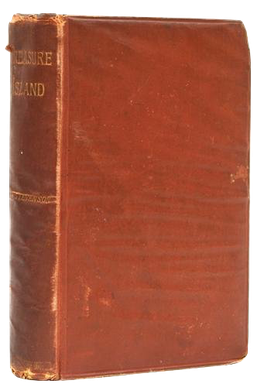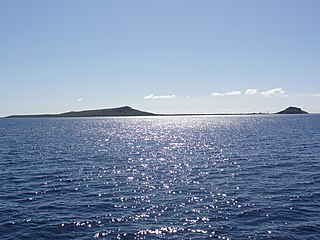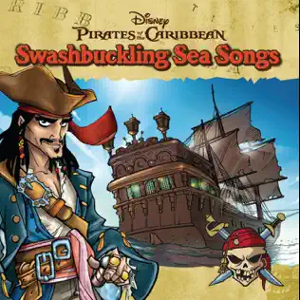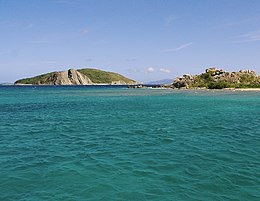Blackbeard and Stevenson
According to an apocryphal story, the pirate Blackbeard marooned his crew on Dead Chest Island as punishment, leaving them with nothing but a cutlass and a bottle of rum each. How many pirates, and how many days, varies according to the source retelling the story. By the end of the month, only a few of pirates were left alive. Because the earliest known references to this story are from the 20th century, it is almost certainly fakelore derived from Robert Louis Stevenson's song "Dead Man's Chest", which first appeared in his novel Treasure Island in 1883. The chorus of "Dead Man's Chest" is as follows:
Fifteen men on the dead man's chest—
...Yo-ho-ho, and a bottle of rum!
Drink and the devil had done for the rest—
...Yo-ho-ho, and a bottle of rum!
Stevenson found the name "Dead Man's Chest" among a list of island names in a book by Charles Kingsley and said "Treasure Island came out of Kingsley's At Last: A Christmas in the West Indies (1871); where I got the 'Dead Man's Chest' - that was the seed". [2] [3] [4] Kingsley had written in At Last: "Unfortunately, English buccaneers have since then [1493] have given to most of them [the Virgin Islands] less poetic names. The Dutchman's Cap, Broken Jerusalem, The Dead Man's Chest, Rum Island, and so forth, mark a time and a race more prosaic, but still more terrible, though not one whit more wicked and brutal, than the Spanish conquistadores." [2] In other words, the song is not based on a former legend, it is entirely new as of 1883 and original with Stevenson. While the two names are not exactly the same ("Dead Man's Chest" vs "Dead Chest"), the similarities are striking, and there are no other islands named like it in the Virgin Islands, suggesting they are one and the same. If on the other hand the island "Dead Man's Chest" referenced by Kingsley in At Last is not the same as the island known today as "Dead Chest Island", then there would be no connection between "Dead Chest Island" and Stevenson's song "Dead Man's Chest", since Stevenson's song is in reference to Kingsley's island.
In 1994, a journalist, Quentin van Marle, spent 31 days alone on the island as a voluntary castaway, beating the supposed record of Blackbeard's pirates and in commemoration of the centenary of Robert Louis Stevenson's death. [5]

Treasure Island is both an 1883 adventure novel and a historical novel set in the 1700s by Scottish author Robert Louis Stevenson, telling a story of "buccaneers and buried gold". It is considered a coming-of-age story and is noted for its atmosphere, characters, and action.

Pirates of the Caribbean is a dark ride at Disneyland, Walt Disney World's Magic Kingdom, Tokyo Disneyland and Disneyland Park at Disneyland Paris.

Marooning is the intentional act of abandoning someone in an uninhabited area, such as a desert island, or more generally to be marooned is to be in a place from which one cannot escape. The word is attested in 1699, and is derived from the term maroon, a word for a fugitive slave, which could be a corruption of Spanish cimarrón, meaning a household animal who has "run wild". Cimarrón in turn may be derived from the Taino word símaran (“wild”), from símara (“arrow”).

Captain Jack Sparrow is a fictional character and the main protagonist of the Pirates of the Caribbean film series and franchise. An early iteration of Sparrow was created by screenwriters Ted Elliott and Terry Rossio, but the final version of the character was created by actor Johnny Depp, who also portrayed him.

Captain Hector Barbossa is a fictional character of the Pirates of the Caribbean franchise, depicted by Geoffrey Rush and appearing in all five films in the series. He first debut in The Curse of the Black Pearl (2003) as a cursed undead skeleton, where he dies at the end of the film. However, the character is revealed to have been resurrected and brought back from the dead by Tia Dalma by the end of Dead Man's Chest, and has since appeared in an anti-heroic role. Captain Hector Barbossa was one of the nine Pirate Lords in At World's End (2007), a privateer in service to King George II and the British Navy while also seeking revenge against Blackbeard in On Stranger Tides (2011), as well as a rich rogue and influential leader of a prosperous pirate empire and fleet in Dead Men Tell No Tales (2017). Throughout the series, Barbossa has been conceptualized as a "dark trickster" and the evil counterpart of Captain Jack Sparrow.

Pirates of the Caribbean: Dead Man's Chest is a 2006 American fantasy swashbuckler film directed by Gore Verbinski, written by Ted Elliott and Terry Rossio, and produced by Jerry Bruckheimer. The sequel to Pirates of the Caribbean: The Curse of the Black Pearl (2003), it is the second installment in the Pirates of the Caribbean film series. Set one year after the events of The Curse of the Black Pearl, the film recounts Captain Jack Sparrow owing a debt to Davy Jones, the ghastly captain of the Flying Dutchman, and being marked for death and pursued by the Kraken. Meanwhile, the wedding of Will Turner and Elizabeth Swann is interrupted by Lord Cutler Beckett, who wants Turner to acquire Jack's magic compass in a bid to find the Dead Man's Chest.

Norman Island is an island at the southern tip of the British Virgin Islands archipelago. It is one of a number of islands reputed to be the inspiration for Robert Louis Stevenson's pirate novel Treasure Island.

Caja de Muertos is an uninhabited island off the southern coast of Puerto Rico, in the municipality of Ponce. The island and its surrounding waters are protected by the Caja de Muertos Nature Reserve, because of its native turtle traffic and ecological value of its dry forests and reefs. Hikers and beachgoers are often seen in the island, which can be reached by ferry from the La Guancha Boardwalk sector of Ponce Playa. Together with Cardona, Ratones, Morrillito, Isla del Frio, Gatas, and Isla de Jueyes, Caja de Muertos is one of seven islands ascribed to the municipality of Ponce.
"Dead Man's Chest" is a fictional sea song, originally from Robert Louis Stevenson's novel Treasure Island (1883). It was expanded in a poem, titled "Derelict" by Young E. Allison, published in the Louisville Courier-Journal in 1891. It has since been used in many later works of art in various forms.

The Black Pearl is a fictional ship in the Pirates of the Caribbean film series. In the screenplay, the ship is easily recognized by her distinctive black hull and sails. Captained by Captain Jack Sparrow, the Black Pearl is said to be "nigh uncatchable". In the first three films, she either overtakes or flees all other ships, including both the Interceptor, which is regarded as the fastest ship in the Caribbean, and the Flying Dutchman, which is faster than the wind. Her speed is derived from several factors such as the large number of sails she carries and being partly supernatural. As stated in Dead Man's Chest and At World's End, the Black Pearl is "the only ship that can outrun the Dutchman" and this is evidenced in the maelstrom battle between the two ships in the movies.
"Yo Ho (A Pirate's Life for Me)" is the theme song for the Pirates of the Caribbean attractions at Disney theme parks. The music was written by George Bruns, with lyrics by Xavier Atencio. The version heard at Disneyland and Walt Disney World's Magic Kingdom was sung by the Mellomen, featuring Thurl Ravenscroft.

Blackbeard the Pirate is a 1952 Technicolor adventure film directed by Raoul Walsh and starring Robert Newton, Linda Darnell, William Bendix, Keith Andes, and Torin Thatcher. The film was made by RKO Radio Pictures and produced by Edmund Grainger from a screenplay by Alan Le May based on the story by DeVallon Scott.

Buccaneer Bunny is a 1948 Looney Tunes cartoon directed by Friz Freleng. The short was released on May 8, 1948, and features Bugs Bunny and Yosemite Sam.

In English-speaking popular culture, the modern pirate stereotype owes its attributes mostly to the imagined tradition of the 18th-century Caribbean pirate sailing off the Spanish Main and to such celebrated 20th-century depictions as Captain Hook and his crew in the theatrical and film versions of J. M. Barrie's children's book Peter Pan, Robert Newton's portrayal of Long John Silver in the 1950 film adaptation of the Robert Louis Stevenson novel Treasure Island, and various adaptations of the Middle Eastern pirate, Sinbad the Sailor. In these and countless other books, films, and legends, pirates are portrayed as "swashbucklers" and "plunderers". They are shown on ships, often wearing eyepatches or peg legs, having a parrot perched on their shoulder, speaking in a West Country accent, and saying phrases like "Arr, matey" and "Avast, me hearty". Pirates have retained their image through pirate-themed tourist attractions, film, toys, books and plays.

Piracy in the British Virgin Islands was prevalent during the so-called "Golden Age of Piracy", mainly during the years of 1690-1730. Privateering was also widely practised in the jurisdiction throughout frequent colonial wars, not least by emancipated slaves who, with in preference to back-breaking labour in the fields for pitiful wages, took enormous risks to capture fortunes on the seas with the sanction of the Crown. In 1808, Patrick Colquhoun, a prize agent for the Territory spoke of "the most daring outrages which are frequently committed by people of colour."

Disney's Pirates of the Caribbean: Swashbuckling Sea Songs was released on CD in 2007, as part of a CD/DVD combo pack, packaged with Pirates of the Caribbean: Dead Man's Chest, and offered at Wal-Mart stores. The CD contained the following 14 tracks, by Various Artists.
- Away, Away, Away (2:45)
- Treasure (2:06)
- The First Mate Is a Monkey (2:28)
- Welcome to the Caribbean (2:57)
- Stowaway Listen Listen (2:41)
- The Legend of Davy Jones (3:41)
- Shiver My Timbers (2:18)
- Yo, Ho, Ho (2:01)
- Sailing for Adventure (2:33)
- Blow the Man Down (2:51)
- The Pirate King (2:22)
- Pirates of the Black Tide (3:10)
- Davy Jones' Locker (2:33)
- Yo Ho (5:43)
Israel Hands, also known as Basilica Hands, was an 18th-century pirate best known for being second in command to Edward Teach, better known as Blackbeard. His name serves as the basis for the name of the villainous sidekick in Robert Louis Stevenson's 1883 novel Treasure Island.
Edward Teach, better known as Blackbeard, was a notorious English pirate who operated around the West Indies and the eastern coast of the American colonies during the early 18th century. He captained the Queen Anne's Revenge, a 200-ton frigate originally named the Concord, and died in a fierce battle with troops from Virginia on November 22, 1718, at Ocracoke Island.















